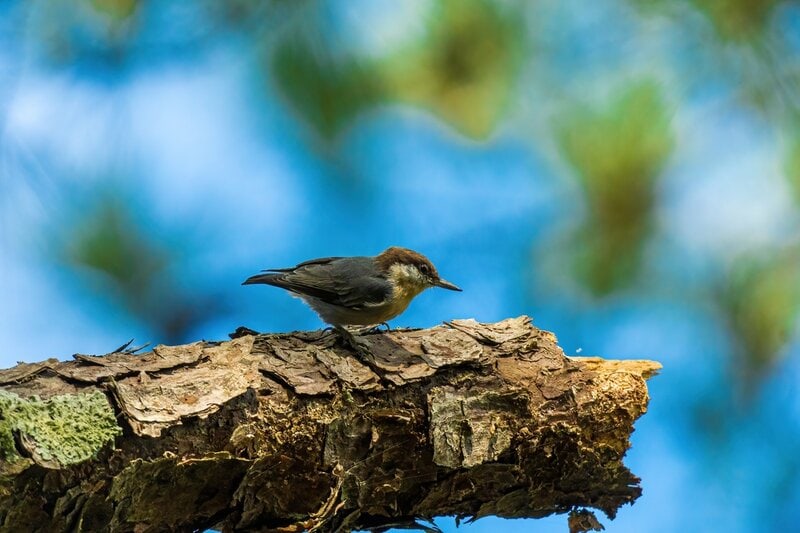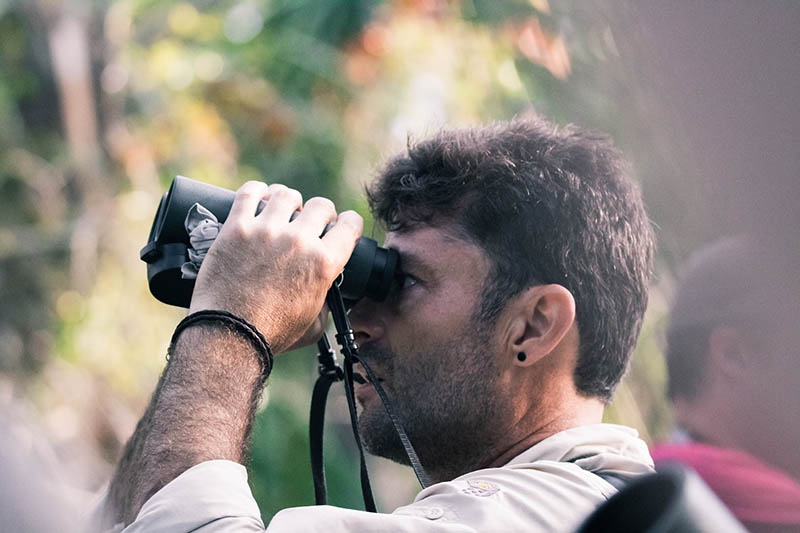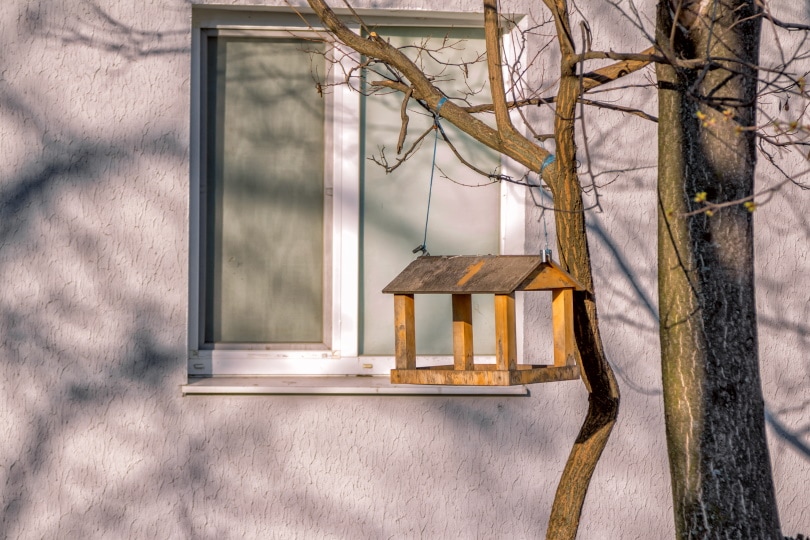Bahama Nuthatch: Field Guide, Pictures, Habitat & Info
Last Updated on

Scientifically referred to as the Sitta Pusilla Insularis, the Bahama Nuthatch is one of the rarest birds on the planet. It’s also part of the passerine family, otherwise known as the perching birds. Contrary to popular belief, the Bahama Nuthatch is not related to the woodpecker species. If anything, they are more closely related to the tufted titmice and chickadees.
Why is it called the Bahama Nuthatch? Well, they have this strange habit of jamming nuts into tree bark so that they can comfortably whack them using their pointy bills. Ostensibly, that’s the only way they know how to “hatch” out the seeds found inside.
“Nuthatch” is descriptive of that practice, and as for “Bahama,” it’s a reminder of where they hail from.

Quick Facts about the Bahama Nuthatch
| Habitat | Open, Mature Pine Forest |
| Diet | Insects |
| Behavior | Territorial, Aggressive |
| Nesting | Cooperative Breeding |
| Conservation | Critically Endangered |
| Scientific Name | Sitta Pusilla Insularis |
| Lifespan | 8 years |
Bahama Nuthatch General Description
Considering we’re looking at a songbird, it’s no surprise that this Nuthatch species is small and compact. It also looks round from a distance, courtesy of its short neck and tiny legs. The bill is chisel-shaped, and it’s attached to an entirely brown head.
When you take a closer look at their plumage, you quickly realize that there are no major differences between the males and females, or even the juveniles. This bird likes to zigzag up pine trees, hopping from one branch to the next. They are social with one another, seeing as they prefer to forage or roost in small groups.
https://www.instagram.com/p/CP1WU0dNz0F/
Range, Habitat, Behavior, Diet & Nesting
Range
As we said, the Bahama Nuthatch is not the type of species that you see every day. If you’re not part of the Caribbean community, and you happen to come across one, chances are it was caught and shipped to your location.
Some birders reckon that they are also found in the United States, but those that are in the states are the Brown-Headed Nuthatch species. They share a relatively similar genetic makeup, but that’s all.
We’ve been told that the Bahama Nuthatches are endemic to a small island in the Bahamas, infamously known as the Grand Bahamas.
Habitat
We believe their natural habitats are characterized by pine forests and thin understories. A forest understory is basically a layer of vegetation that comprises shrubs and several species of small trees, growing between the forest floor and canopy. This part of the forest is always warm, damp, and very sheltered, thanks to the canopy.
You see, all these conditions are ideal for breeding, and that’s why the Bahama Nuthatch often finds it hard to leave. Even if they do for some reason—let’s assume due to forest fires—they’ll relocate somewhere close, and then move back after a while.
Behavior
“Endearing” and “unusual” are words often used to describe the behavior of the Bahama Nuthatch. Primarily because this species is one of the few birds that subscribes to co-operative parenting/ breeding. Both the sexes will work together to build their nest, sanitize it, and even make sure the hatchlings and fledglings are well fed.
Even while incubating the eggs, the female still relies on her partner to provide food and always be around to protect the nest.
https://www.instagram.com/p/CQ_h4A_N9Z4/
Diet
The Bahama Nuthatch’s diet is normally rich in protein, as they love feeding on insects and grubs. But this shouldn’t be surprising considering they’ve always been classified as insectivores. What’s fascinating is how they forage for that food.
On more than one occasion, they’ve been spotted holding bark chips using their beaks. If they suspect insects are hiding close by, under the bark of a tree, they’ll use the chips as tools to pry off those sections. Eventually gaining access and devouring them all.
Nesting
You should note that the Bahama Nuthatch is monogamous in nature. However, their definition of monogamy is different, in that they believe in maintaining a partner for just one season. Some will do two seasons, others several, but most of the time it’s one.
They’ll only construct their own nests from scratch if they can’t find any hollow left behind by the woodpecker or a nesting box. The nest has to be at least 5 feet off the ground and built using plant material that’s waterproof. If the conditions are favorable, the female will lay three to nine eggs. This species is very territorial, so expect it to attack anyone or anything that tries to invade its personal space.
How to Find the Bahama Nuthatch: Birdwatching Tips
Looking for a bird is not about gazing around and hoping you’ll spot the species that you’re interested in. It’s a technique, as you have to know what to listen for, when to look, and the unique attributes of the species.

What to Listen For
From what we’ve heard, the Bahama Nuthatch sort of sounds like a squeezed rubber duck. If you’ve never squeezed one before, just know that the sound produced is short, sharp, and high-pitched. It’s kind of cute when you first hear it but quickly starts to get irritating over time.
What to Look For
In terms of their physical appearance, we wouldn’t say that the Bahama Nuthatch exhibits sexual dimorphisms. They are monomorphic, meaning the size and plumage color of both sexes will be similar. The fledglings share the same physical attributes as their parents.
Their underbellies are light brown, while the back and tail are predominantly blue-gray. If you’re lucky to get close enough, you’ll be able to see white markings on the feathers and a whitish neck.
When to Look
The Bahama Nuthatch is a diurnal creature. So, you’ll be wasting your time if you’re out birding at night. In our opinion, the best time to check them out is very early in the morning, while they are foraging for breakfast. If the weather is great, they’ll remain active till midday or even past that time.
Attracting the Bahama Nuthatch to Your Backyard: Tips & Tricks
You could attract these birds to your backyard if you live on the island. But if you’ve never even heard of a single sighting in your location, don’t bother trying. They are not the type of species that just shows up randomly unless they are running away from a catastrophe. Like, say, hurricanes and forest fires.
These are some of the tips and tricks:
https://www.instagram.com/p/Bni8G3YlpMe/
Plant Native Grass
Bahama Nuthatches love eating insects more than anything else. And insects like to seek refuge in grasses, obviously hiding from predators. Therefore, if you want the bird to pay you a visit during spring or summer, you need to transform your yard into an insect hub.
Plant Pine Trees
This species loves this tree because it not only provides a suitable nesting site during their breeding season but also offers concealment in case a predator shows up and shelter against the harsh weather elements.
Install Bird Feeders
You really don’t have to go for the costly feeders if you’re working with a shoestring budget. A bird feeder is something that can be a DIY project. And there are many sources on the internet with simple and clear instructions on how to build one.
Hang the feeder next to your bedroom window or on a tree. Also, don’t forget about the bird bath, as water is essential to their survival.

Bahama Nuthatch Conservation: Is this Bird Threatened?
For several years now, this species has been tagged as “Critically Endangered.” We initially thought that they just had a restrictive range and were not so common in most parts of the world, but their population numbers have been drastically dropping. From the information that we’ve gathered, they are being threatened by hurricanes, forest fires, degradation, and habitat destruction.
Humans are not the only party at fault here, as we’ve also noted that several invasive species have contributed to this decline. To mention a few, we’re referring to the Common Starling, House Sparrows, Raccoons, And Corn Snakes.
Even though it’s not confirmed, some people have started to speculate that hurricane Dorian completely wiped out whatever was left of their population. This catastrophe occurred 3 years ago, and a press release intimated that the flooding adversely affected the areas where they were last sighted. A few of the pines were still standing after the storm had passed, but unfortunately, there was no bird in sight.

Summing Up
Some people think the Bahama Nuthatch is a subspecies of the Brown-Headed Nuthatch, but there was a study conducted 3 years ago that proved otherwise. Of course, they are related genetically, but the differences are not that marginal. The Brown-Headed Nuthatch has a fairly longer beak, darker facial stripe, and distinct warbling call.
Is the Bahama Nuthatch extinct? We don’t know. Considering they were last sighted a little over 2 years ago, we feel like it’s still too soon to make any speculations. But if you see one, be sure to let us know.
Featured Image Credit: Wileydoc, Shutterstock
Table of Contents
About the Author Robert Sparks
Robert’s obsession with all things optical started early in life, when his optician father would bring home prototypes for Robert to play with. Nowadays, Robert is dedicated to helping others find the right optics for their needs. His hobbies include astronomy, astrophysics, and model building. Originally from Newark, NJ, he resides in Santa Fe, New Mexico, where the nighttime skies are filled with glittering stars.
Related Articles:
10 Types of Hummingbirds in Arkansas (With Pictures)
8 Types of Hummingbirds in Nebraska (With Pictures)
5 Types of Hummingbirds in Idaho (With Pictures)
3 Types of Hummingbirds in Mississippi (With Pictures)
8 Types of Hummingbirds in Kansas (With Pictures)
5 Types of Hummingbirds in West Virginia (With Pictures)
5 Types of Hummingbirds in Ohio (With Pictures)
Where Do Nuthatches Nest? Nuthatch Nesting Habits Explained
